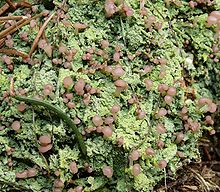Baeomyces rufus
| Baeomyces rufus | |
|---|---|

| |
| Scientific classification | |
| Domain: | Eukaryota |
| Kingdom: | Fungi |
| Division: | Ascomycota |
| Class: | Lecanoromycetes |
| Order: | Baeomycetales |
| Family: | Baeomycetaceae
|
| Genus: | Baeomyces |
| Species: | B. rufus
|
| Binomial name | |
| Baeomyces rufus (
Rebent. (1804)[1] | |
| Synonyms | |
| |
Baeomyces rufus, commonly known as the brown beret lichen,.
Taxonomy
William Hudson described this species as Lichen rufus in 1762.
The similar-appearing lichen D. baeomyces was formerly identified as Baeomyces roseus; it was not until 1997 that a study by Soili Stenroos and Paula DePriest used DNA sequencing to establish that the species now called Dibaeis baeomyces did not belong to the genus Baeomyces. B. rufus was the lichen representing genus Baeomyces whose DNA was sequenced for comparison with B. roseus/D. baeomyces.[5]
Description
B. rufus is characterized by bulbous
Similar species
B. rufus can be confused with Dibaeis baeomyces, particularly when the former's fruiting bodies are more pink than brown, but the two can be distinguished by morphological differences such as D. baeomyces's larger bulbs or the translucent appearance of B. rufus's apothecia when wet, and by differences in habit, as D. baeomyces thrives in full sun whereas B. rufus avoids it.[3] With a light microscope, B. rufus can easily be distinguished by its apothecial stalks, as D. baeomyces has apothecia directly on the thallus, without a stalk.[8]
Distribution and habitat
This is the most common of the beret or cap lichens.[3] It is found in circumpolar North America,[6] Asia,[7] and Europe; it occurs as far south as Turkey.[9] Its southern ranges are limited to mountainous areas.[9] Typical habitats of B. rufus are temperate pine forests, with moist sites and disturbed ground being particularly preferred.[6] Specimens may grow directly on soil or leaf litter, or on tree bark or stones.[7] Shaded locations are preferred to those that receive direct sunlight.[3]
Varieties
Named varieties of B. rufus include:[10]
- B. r. var. callianthus (meaning: having beautiful flowers)[11]
- B. r. var. carneofulvescens
- B. r. var. chilensis (meaning: from the country Chile)[12]
- B. r. var. monstrosus (meaning: abnormal, enormous, malformed)[13]
- B. r. var. piceicola
- B. r. var. prostii
References
- ^ a b "Baeomyces rufus". MycoBank.org. Retrieved 11 October 2015.
- ^ Mycologia Balcanica, Volumes 1–3. Bulgarian Mycological Society. 2004. p. 52. Retrieved 11 October 2015.
- ^ ISBN 978-0300082494. Retrieved 11 October 2015.
- ^ "Standardized Common Names for Wild Species in Canada". National General Status Working Group. 2020.
- PMID 21680313.
- ^ a b c "CNALH — Baeomyces rufus". LichenPortal.org. Consortium of North American Lichen Herbaria. Retrieved 11 October 2015.
- ^ a b c "Baeomyces rufus (Huds.) Rebent". LIASLight.LIAS.net. Botanische Staatssammlung München. Retrieved 11 October 2015.
- ^ "CNALH - Baeomyces rufus". lichenportal.org. Retrieved 2021-03-26.
- ^ a b "Baeomyces rufus (Huds.) Rebent". EU-Nomen.eu. Pan-European Species directories Infrastructure (PESI). Retrieved 11 October 2015.
- ^ "Taxon Passport: Baeomyces rufus". StrainInfo.net. Archived from the original on 4 March 2016. Retrieved 11 October 2015.
- ^ "Garden Dictionary Word: callianthus". BackyardGardener.com/GardenDictionary. Retrieved 11 October 2015.
- ^ "Garden Dictionary Word: chilensis". BackyardGardener.com/GardenDictionary. Retrieved 11 October 2015.
- ^ "Garden Dictionary Word: monstrosus". BackyardGardener.com/GardenDictionary. Retrieved 11 October 2015.
